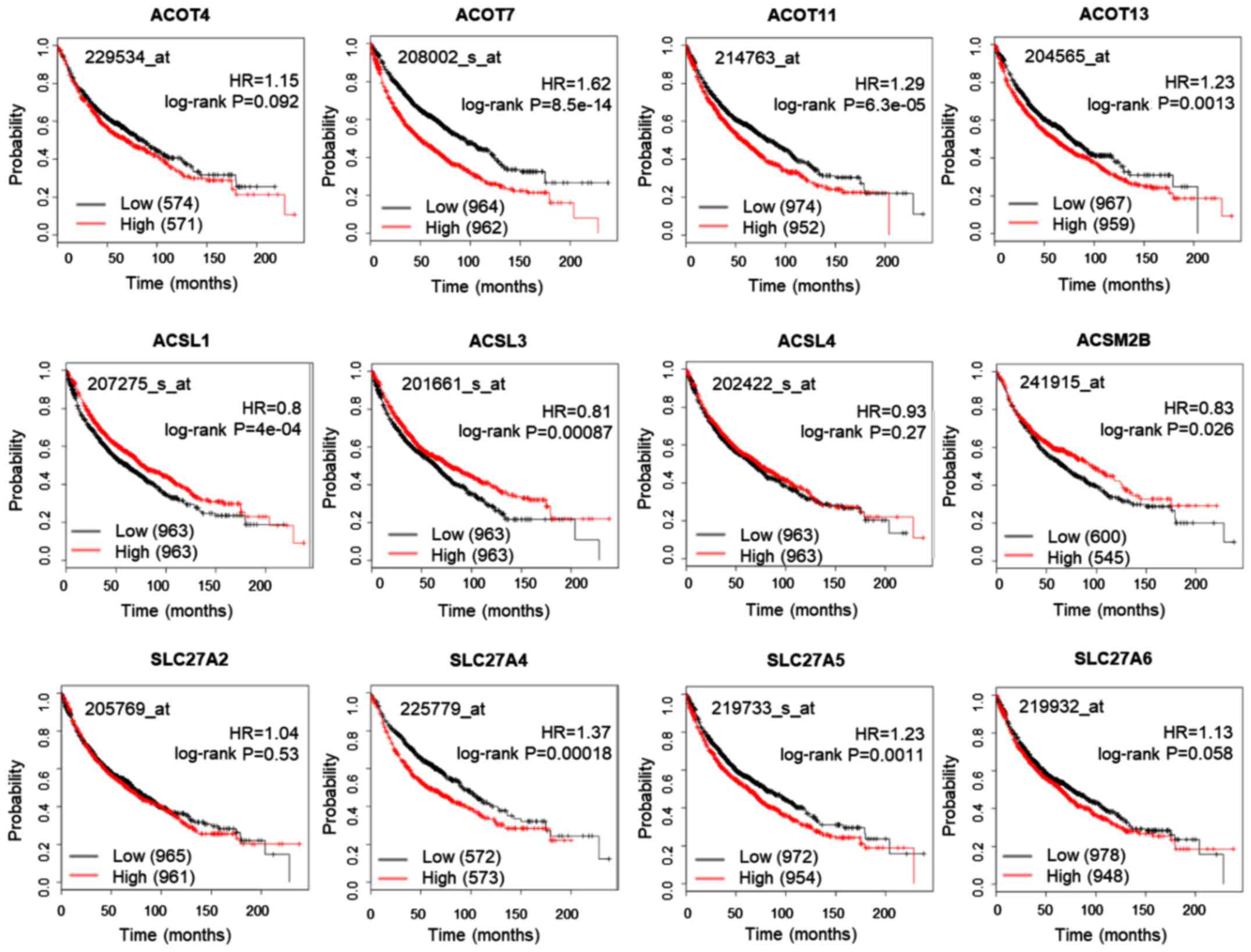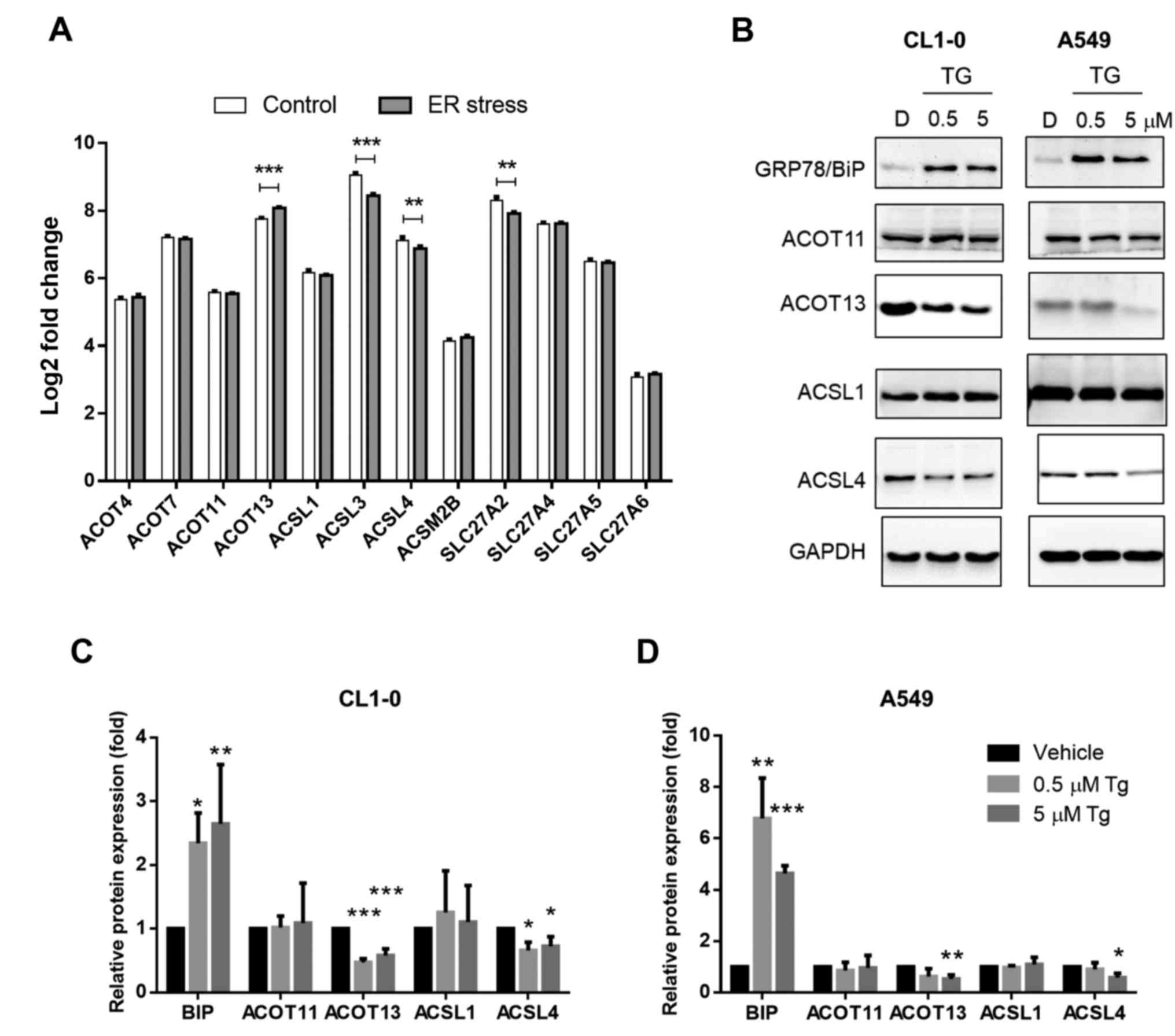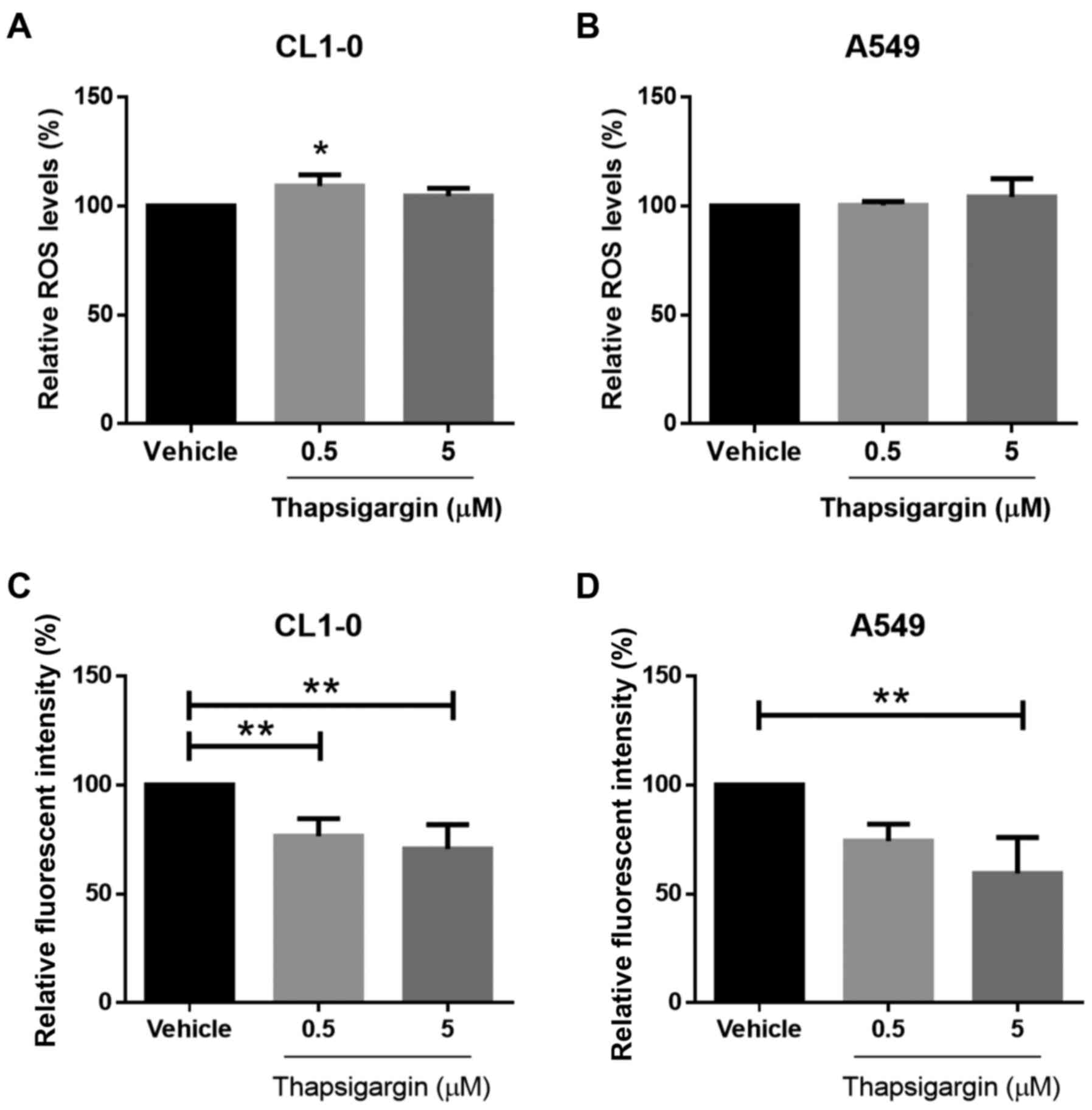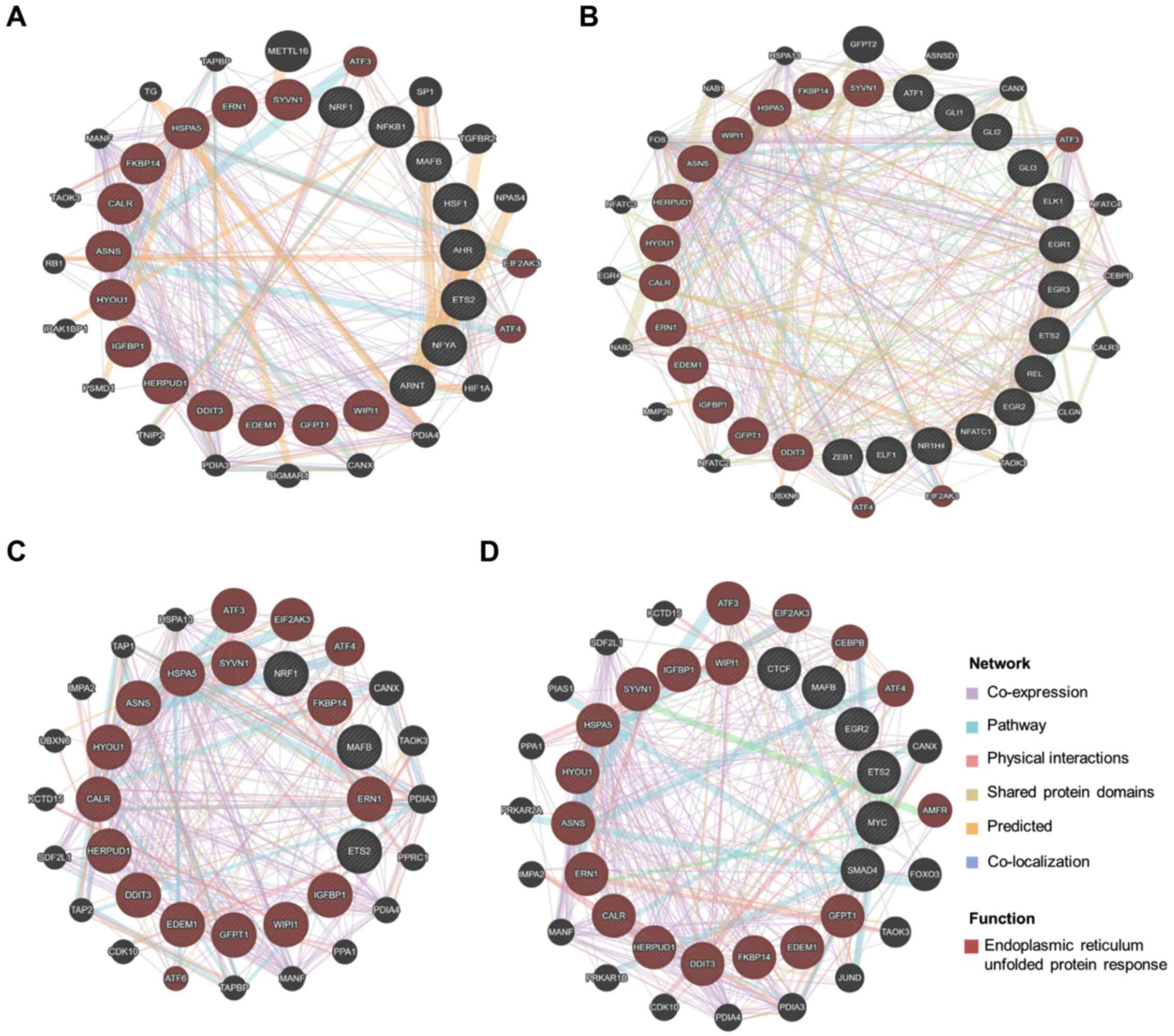|
1
|
Siegel RL, Miller KD and Jemal A: Cancer
statistics, 2017. CA Cancer J Clin. 67:7–30. 2017. View Article : Google Scholar : PubMed/NCBI
|
|
2
|
Stewart B and Wild CP: World Cancer Report
2014International Agency for Research on Cancer. World Health
Organization; 2014, View Article : Google Scholar
|
|
3
|
Chen JQ and Russo J: Dysregulation of
glucose transport, glycolysis, TCA cycle and glutaminolysis by
oncogenes and tumor suppressors in cancer cells. Biochim Biophys
Acta. 1826:370–384. 2012.PubMed/NCBI
|
|
4
|
Locasale JW: Serine, glycine and
one-carbon units: Cancer metabolism in full circle. Nat Rev Cancer.
13:572–583. 2013. View
Article : Google Scholar : PubMed/NCBI
|
|
5
|
Hensley CT, Wasti AT and DeBerardinis RJ:
Glutamine and cancer: Cell biology, physiology, and clinical
opportunities. J Clin Invest. 123:3678–3684. 2013. View Article : Google Scholar : PubMed/NCBI
|
|
6
|
Visca P, Sebastiani V, Botti C, Diodoro
MG, Lasagni RP, Romagnoli F, Brenna A, De Joannon BC, Donnorso RP,
Lombardi G, et al: Fatty acid synthase (FAS) is a marker of
increased risk of recurrence in lung carcinoma. Anticancer Res.
24:4169–4173. 2004.PubMed/NCBI
|
|
7
|
Huang J, Fan XX, He J, Pan H, Li RZ, Huang
L, Jiang Z, Yao XJ, Liu L, Leung EL, et al: SCD1 is associated with
tumor promotion, late stage and poor survival in lung
adenocarcinoma. Oncotarget. 7:39970–39979. 2016.PubMed/NCBI
|
|
8
|
Wen T, Gao L, Wen Z, Wu C, Tan CS, Toh WZ
and Ong CN: Exploratory investigation of plasma metabolomics in
human lung adenocarcinoma. Mol Biosyst. 9:2370–2378. 2013.
View Article : Google Scholar : PubMed/NCBI
|
|
9
|
Liu J, Mazzone PJ, Cata JP, Kurz A, Bauer
M, Mascha EJ and Sessler DI: Serum free fatty acid biomarkers of
lung cancer. Chest. 146:670–679. 2014. View Article : Google Scholar : PubMed/NCBI
|
|
10
|
Zhang Y, He C, Qiu L, Wang Y, Zhang L, Qin
X, Liu Y, Zhang D and Li Z: Serum unsaturated free fatty acids:
Potential biomarkers for early detection and disease progression
monitoring of non-small cell lung cancer. J Cancer. 5:706–714.
2014. View
Article : Google Scholar : PubMed/NCBI
|
|
11
|
Cao SS and Kaufman RJ: Endoplasmic
reticulum stress and oxidative stress in cell fate decision and
human disease. Antioxid Redox Signal. 21:396–413. 2014. View Article : Google Scholar : PubMed/NCBI
|
|
12
|
Yadav RK, Chae SW, Kim HR and Chae HJ:
Endoplasmic reticulum stress and cancer. J Cancer Prev. 19:75–88.
2014. View Article : Google Scholar : PubMed/NCBI
|
|
13
|
Tabas I and Ron D: Integrating the
mechanisms of apoptosis induced by endoplasmic reticulum stress.
Nat Cell Biol. 13:184–190. 2011. View Article : Google Scholar : PubMed/NCBI
|
|
14
|
Corazzari M, Gagliardi M, Fimia GM and
Piacentini M: Endoplasmic reticulum stress, unfolded protein
response, and cancer cell fate. Front Oncol. 7:782017. View Article : Google Scholar : PubMed/NCBI
|
|
15
|
Han J and Kaufman RJ: The role of ER
stress in lipid metabolism and lipotoxicity. J Lipid Res.
57:1329–1338. 2016. View Article : Google Scholar : PubMed/NCBI
|
|
16
|
Lauressergues E, Bert E, Duriez P, Hum D,
Majd Z, Staels B and Cussac D: Does endoplasmic reticulum stress
participate in APD-induced hepatic metabolic dysregulation?
Neuropharmacology. 62:784–796. 2012. View Article : Google Scholar : PubMed/NCBI
|
|
17
|
Griffiths B, Lewis CA, Bensaad K, Ros S,
Zhang Q, Ferber EC, Konisti S, Peck B, Miess H, East P, et al:
Sterol regulatory element binding protein-dependent regulation of
lipid synthesis supports cell survival and tumor growth. Cancer
Metab. 1:32013. View Article : Google Scholar : PubMed/NCBI
|
|
18
|
Faergeman NJ and Knudsen J: Role of
long-chain fatty acyl-CoA esters in the regulation of metabolism
and in cell signalling. Biochem J. 323:1–12. 1997. View Article : Google Scholar : PubMed/NCBI
|
|
19
|
Ellis JM, Bowman CE and Wolfgang MJ:
Metabolic and tissue-specific regulation of acyl-CoA metabolism.
PLoS One. 10:e01165872015. View Article : Google Scholar : PubMed/NCBI
|
|
20
|
Jung WY, Kim YH, Ryu YJ, Kim BH, Shin BK,
Kim A and Kim HK: Acyl-CoA thioesterase 8 is a specific protein
related to nodal metastasis and prognosis of lung adenocarcinoma.
Pathol Res Pract. 209:276–283. 2013. View Article : Google Scholar : PubMed/NCBI
|
|
21
|
Hung JY, Chiang SR, Liu KT, Tsai MJ, Huang
MS, Shieh JM, Yen MC and Hsu YL: Overexpression and proliferation
dependence of acyl-CoA thioesterase 11 and 13 in lung
adenocarcinoma. Oncol Lett. 14:3647–3656. 2017. View Article : Google Scholar : PubMed/NCBI
|
|
22
|
Gentles AJ, Newman AM, Liu CL, Bratman SV,
Feng W, Kim D, Nair VS, Xu Y, Khuong A, Hoang CD, et al: The
prognostic landscape of genes and infiltrating immune cells across
human cancers. Nat Med. 21:938–945. 2015. View Article : Google Scholar : PubMed/NCBI
|
|
23
|
Gyorffy B, Surowiak P, Budczies J and
Lanczky A: Online survival analysis software to assess the
prognostic value of biomarkers using transcriptomic data in
non-small-cell lung cancer. PLoS One. 8:e822412013. View Article : Google Scholar : PubMed/NCBI
|
|
24
|
Barrett T, Wilhite SE, Ledoux P,
Evangelista C, Kim IF, Tomashevsky M, Marshall KA, Phillippy KH,
Sherman PM, Holko M, et al: NCBI GEO: Archive for functional
genomics data sets-update. Nucleic Acids Res. 41:D991–D995. 2013.
View Article : Google Scholar : PubMed/NCBI
|
|
25
|
Pathan M, Keerthikumar S, Chisanga D,
Alessandro R, Ang CS, Askenase P, Batagov AO, Benito-Martin A,
Camussi G, Clayton A, et al: A novel community driven software for
functional enrichment analysis of extracellular vesicles data. J
Extracell Vesicles. 6:13214552017. View Article : Google Scholar : PubMed/NCBI
|
|
26
|
Pathan M, Keerthikumar S, Ang CS, Gangoda
L, Quek CY, Williamson NA, Mouradov D, Sieber OM, Simpson RJ, Salim
A, et al: FunRich: An open access standalone functional enrichment
and interaction network analysis tool. Proteomics. 15:2597–2601.
2015. View Article : Google Scholar : PubMed/NCBI
|
|
27
|
Daily K, Patel VR, Rigor P, Xie X and
Baldi P: MotifMap: Integrative genome-wide maps of regulatory motif
sites for model species. BMC Bioinformatics. 12:4952011. View Article : Google Scholar : PubMed/NCBI
|
|
28
|
Chu YW, Yang PC, Yang SC, Shyu YC, Hendrix
MJ, Wu R and Wu CW: Selection of invasive and metastatic
subpopulations from a human lung adenocarcinoma cell line. Am J
Respir Cell Mol Biol. 17:353–360. 1997. View Article : Google Scholar : PubMed/NCBI
|
|
29
|
Warde-Farley D, Donaldson SL, Comes O,
Zuberi K, Badrawi R, Chao P, Franz M, Grouios C, Kazi F, Lopes CT,
et al: The GeneMANIA prediction server: Biological network
integration for gene prioritization and predicting gene function.
Nucleic Acids Res. 38:W214–W220. 2010. View Article : Google Scholar : PubMed/NCBI
|
|
30
|
Watkins PA: Very-long-chain acyl-CoA
synthetases. J Biol Chem. 283:1773–1777. 2008. View Article : Google Scholar : PubMed/NCBI
|
|
31
|
Digel M, Ehehalt R, Stremmel W and
Fullekrug J: Acyl-CoA synthetases: Fatty acid uptake and metabolic
channeling. Mol Cell Biochem. 326:23–28. 2009. View Article : Google Scholar : PubMed/NCBI
|
|
32
|
Hartmann F, Sparla D, Tute E, Tamm M,
Schneider U, Jeon MK, Kasperk R, Gassler N and Kaemmerer E: Low
acyl-CoA synthetase 5 expression in colorectal carcinomas is
prognostic for early tumour recurrence. Pathol Res Pract.
213:261–266. 2017. View Article : Google Scholar : PubMed/NCBI
|
|
33
|
Sanchez-Martinez R, Cruz-Gil S, de Cedron
Gomez M, Álvarez-Fernández M, Vargas T, Molina S, García B, Herranz
J, Moreno-Rubio J, Reglero G, et al: A link between lipid
metabolism and epithelial-mesenchymal transition provides a target
for colon cancer therapy. Oncotarget. 6:38719–38736. 2015.
View Article : Google Scholar : PubMed/NCBI
|
|
34
|
Cruz-Gil S, Sanchez-Martinez R, de Cedron
Gomez M, Martin-Hernandez R, Vargas T, Molina S, Herranz J, Davalos
A, Reglero G and de Molina Ramirez A: Targeting the lipid metabolic
axis ACSL/SCD in colorectal cancer progression by therapeutic
miRNAs: miR-19b-1 role. J Lipid Res. 59:14–24. 2018. View Article : Google Scholar : PubMed/NCBI
|
|
35
|
Yen MC, Kan JY, Hsieh CJ, Kuo PL, Hou MF
and Hsu YL: Association of long-chain acyl-coenzyme A synthetase 5
expression in human breast cancer by estrogen receptor status and
its clinical significance. Oncol Rep. 37:3253–3260. 2017.
View Article : Google Scholar : PubMed/NCBI
|
|
36
|
Hung YH, Chan YS, Chang YS, Lee KT, Hsu
HP, Yen MC, Chen WC, Wang CY and Lai MD: Fatty acid metabolic
enzyme acyl-CoA thioesterase 8 promotes the development of
hepatocellular carcinoma. Oncol Rep. 31:2797–2803. 2014. View Article : Google Scholar : PubMed/NCBI
|
|
37
|
Jung SH, Lee HC, Hwang HJ, Park HA, Moon
YA, Kim BC, Lee HM, Kim KP, Kim YN, Lee BL, et al: Acyl-CoA
thioesterase 7 is involved in cell cycle progression via regulation
of PKCzeta-p53-p21 signaling pathway. Cell Death Dis. 8:e27932017.
View Article : Google Scholar : PubMed/NCBI
|
|
38
|
Tillander V, Alexson SEH and Cohen DE:
Deactivating fatty acids: Acyl-coa thioesterase-mediated control of
lipid metabolism. Trends Endocrinol Metab. 28:473–484. 2017.
View Article : Google Scholar : PubMed/NCBI
|
|
39
|
Hunt MC, Rautanen A, Westin MA, Svensson
LT and Alexson SE: Analysis of the mouse and human acyl-CoA
thioesterase (ACOT) gene clusters shows that convergent, functional
evolution results in a reduced number of human peroxisomal ACOTs.
FASEB J. 20:1855–1864. 2006. View Article : Google Scholar : PubMed/NCBI
|
|
40
|
Forwood JK, Thakur AS, Guncar G, Marfori
M, Mouradov D, Meng W, Robinson J, Huber T, Kellie S, Martin JL, et
al: Structural basis for recruitment of tandem hotdog domains in
acyl-CoA thioesterase 7 and its role in inflammation. Proc Natl
Acad Sci U S A. 104:10382–10387. 2007. View Article : Google Scholar : PubMed/NCBI
|
|
41
|
Han S and Cohen DE: Functional
characterization of thioesterase superfamily member 1/Acyl-CoA
thioesterase 11: Implications for metabolic regulation. J Lipid
Res. 53:2620–2631. 2012. View Article : Google Scholar : PubMed/NCBI
|
|
42
|
Basseri S and Austin RC: Endoplasmic
reticulum stress and lipid metabolism: Mechanisms and therapeutic
potential. Biochem Res Int. 2012:8413622012. View Article : Google Scholar : PubMed/NCBI
|















